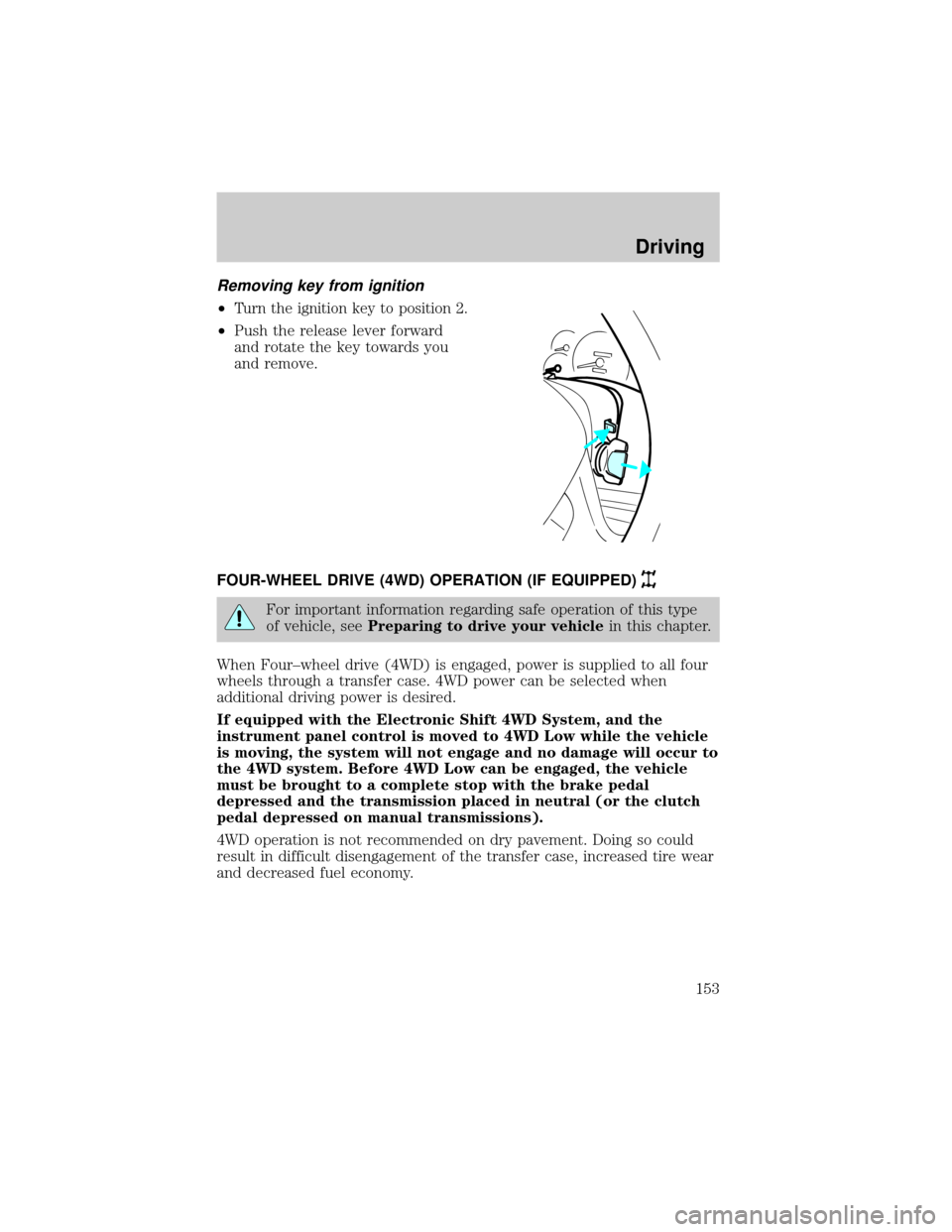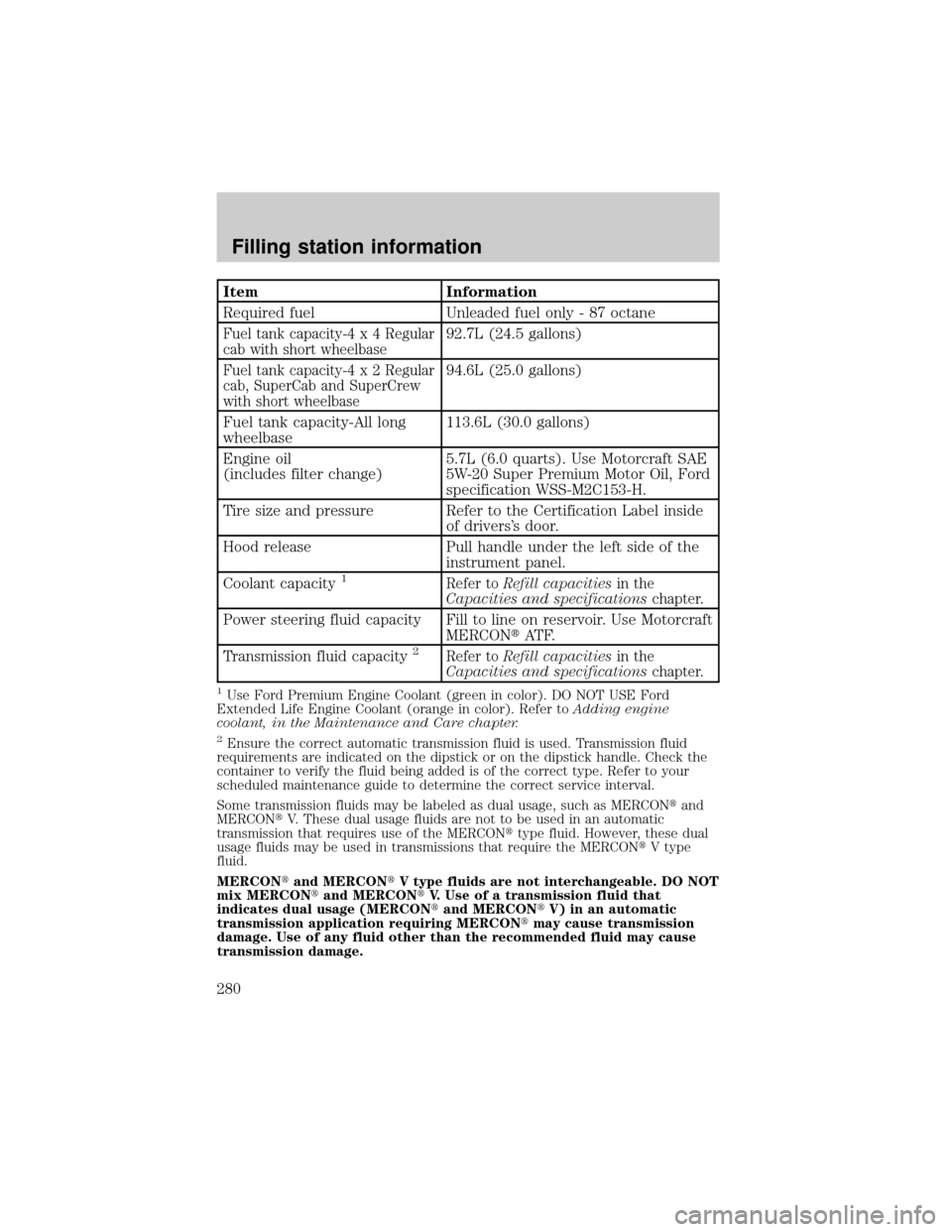Page 153 of 280

Removing key from ignition
²Turn the ignition key to position 2.
²Push the release lever forward
and rotate the key towards you
and remove.
FOUR-WHEEL DRIVE (4WD) OPERATION (IF EQUIPPED)
For important information regarding safe operation of this type
of vehicle, seePreparing to drive your vehiclein this chapter.
When Four±wheel drive (4WD) is engaged, power is supplied to all four
wheels through a transfer case. 4WD power can be selected when
additional driving power is desired.
If equipped with the Electronic Shift 4WD System, and the
instrument panel control is moved to 4WD Low while the vehicle
is moving, the system will not engage and no damage will occur to
the 4WD system. Before 4WD Low can be engaged, the vehicle
must be brought to a complete stop with the brake pedal
depressed and the transmission placed in neutral (or the clutch
pedal depressed on manual transmissions).
4WD operation is not recommended on dry pavement. Doing so could
result in difficult disengagement of the transfer case, increased tire wear
and decreased fuel economy.
Driving
153
Page 233 of 280

5. Follow one of the simple calculations in order to determine fuel
economy:
Multiply liters used by 100, then divide by total kilometers
traveled.
Divide total miles traveled by total gallons used.
Keep a record for at least one month and record the type of driving (city
or highway). This will provide an accurate estimate of the vehicle's fuel
economy under current driving conditions. Additionally, keeping records
during summer and winter will show how temperature impacts fuel
economy. In general, lower temperatures give lower fuel economy.
Driving style Ð good driving and fuel economy habits
Give consideration to the lists that follow and you may be able to change
a number of variables and improve your fuel economy.
Habits
²Smooth, moderate operation can yield up to 10% savings in fuel.
²Steady speeds without stopping will usually give the best fuel
economy.
²Idling for long periods of time (greater than one minute) may waste
fuel.
²Anticipate stopping; slowing down may eliminate the need to stop.
²Sudden or hard accelerations may reduce fuel economy.
²Slow down gradually.
²Driving at reasonable speeds (traveling at 88 km/h [55 mph] uses 15%
less fuel than traveling at 105 km/h [65 mph]).
²Revving the engine before turning it off may reduce fuel economy.
²Using the air conditioner or defroster may reduce fuel economy.
²
You may want to turn off the speed control in hilly terrain if
unnecessary shifting between third and fourth gear occurs. Unnecessary
shifting of this type could result in reduced fuel economy.
²Warming up a vehicle on cold mornings is not required and may
reduce fuel economy.
²Resting your foot on the brake pedal while driving may reduce fuel
economy.
²Combine errands and minimize stop-and-go driving.
Maintenance and care
233
Page 253 of 280

fluid. However, these dual usage fluids may be used in transmissions that
require the MERCONtV type fluid.
MERCONtand MERCONtV type fluids are not interchangeable.
DO NOT mix MERCONtand MERCONtV. Use of a transmission
fluid that indicates dual usage (MERCONtand MERCONtV) in
an automatic transmission application requiring MERCONtmay
cause transmission damage. Use of any fluid other than the
recommended fluid may cause transmission damage.
ENGINE DATA
Engine 4.2L V6 engine 4.6L V8 engine 5.4L V8 engine
Cubic inches 256 281 330
Required fuel 87 octane 87 octane 87 octane
Firing order 1-4-2-5-3-6 1-3-7-2-6-5-4-8 1-3-7-2-6-5-4-8
Spark plug gap1.3-1.4 mm
(0.052-0.056 inch)1.3-1.4 mm
(0.052-0.056 inch)1.3-1.4 mm
(0.052-0.056 inch)
Ignition system EDIS Coil on plug Coil on plug
Compression
ratio9.3:1 9.0:19.37:1 9.0:1
VEHICLE DIMENSIONS
Styleside
DimensionBody Style
Regular
Cab 4x2Regular Cab
4x4Super Cab
4x2Super Cab
4x4
(1) Overall
length5 205 mm
(204.9 in)
(SWB)
5 678 mm
(223.5 in)
(LWB)5 250 mm
(206.7 in)
(SWB)
5 716 mm
(225.0 in)
(LWB)5 607 mm
(220.7 in)
(SWB)
6 150 mm
(242.1 in)
(LWB)5 722 mm
(225.3 in)
(SWB)
6 188 mm
(243.6 in)
(LWB)
(2) Overall
width2 019 mm
(79.5 in)
12 019 mm
(79.5 in)11 989 mm
(78.3 in)12 019 mm
(79.5 in)1
Capacities and specifications
253
Page 280 of 280

Item Information
Required fuel Unleaded fuel only - 87 octane
Fuel tank capacity-4 x 4 Regular
cab with short wheelbase92.7L (24.5 gallons)
Fuel tank capacity-4 x 2 Regular
cab, SuperCab and SuperCrew
with short wheelbase94.6L (25.0 gallons)
Fuel tank capacity-All long
wheelbase113.6L (30.0 gallons)
Engine oil
(includes filter change)5.7L (6.0 quarts). Use Motorcraft SAE
5W-20 Super Premium Motor Oil, Ford
specification WSS-M2C153-H.
Tire size and pressure Refer to the Certification Label inside
of drivers's door.
Hood release Pull handle under the left side of the
instrument panel.
Coolant capacity
1Refer toRefill capacitiesin the
Capacities and specificationschapter.
Power steering fluid capacity Fill to line on reservoir. Use Motorcraft
MERCONtAT F.
Transmission fluid capacity
2Refer toRefill capacitiesin the
Capacities and specificationschapter.
1Use Ford Premium Engine Coolant (green in color). DO NOT USE Ford
Extended Life Engine Coolant (orange in color). Refer toAdding engine
coolant, in the Maintenance and Care chapter.
2Ensure the correct automatic transmission fluid is used. Transmission fluid
requirements are indicated on the dipstick or on the dipstick handle. Check the
container to verify the fluid being added is of the correct type. Refer to your
scheduled maintenance guide to determine the correct service interval.
Some transmission fluids may be labeled as dual usage, such as MERCONtand
MERCONtV. These dual usage fluids are not to be used in an automatic
transmission that requires use of the MERCONttype fluid. However, these dual
usage fluids may be used in transmissions that require the MERCONtV type
fluid.
MERCONtand MERCONtV type fluids are not interchangeable. DO NOT
mix MERCONtand MERCONtV. Use of a transmission fluid that
indicates dual usage (MERCONtand MERCONtV) in an automatic
transmission application requiring MERCONtmay cause transmission
damage. Use of any fluid other than the recommended fluid may cause
transmission damage.
Filling station information
280